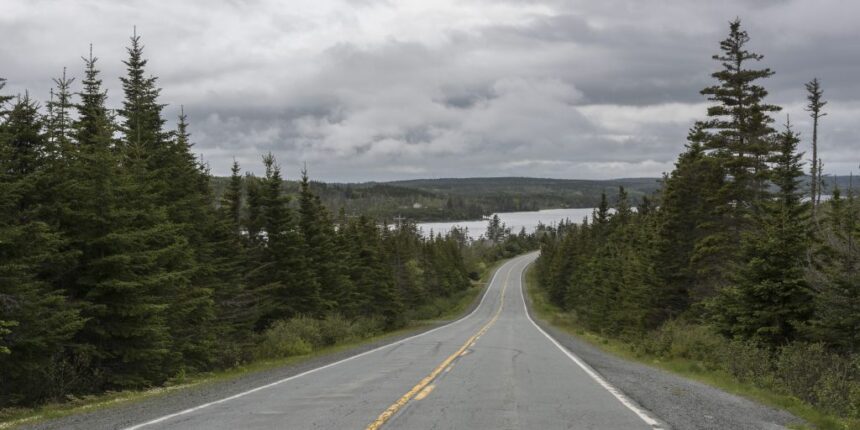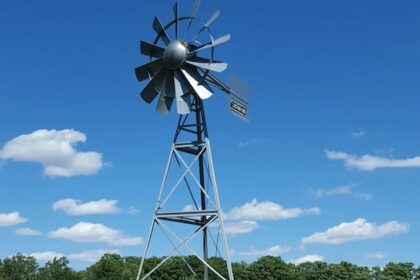Just outside the town of Port Hawkesbury, N.S., the shoreline of the Strait of Canso is dotted with industry. “For Nova Scotia, this is one of the last outposts of industrial activity,” Amanda Mombourquette says, steering her SUV. Out one window, towering mounds of coal are piled outside the Point Tupper Generating Station, while tanks and pipelines from a former oil refinery carve up the slope. A short distance down the road, Nova Scotia’s last papermill standing stretches across the hill. Although the area supports hundreds of jobs, there’s little traffic on a sunny October afternoon. Pulling her car to the side of Industrial Park Road, Mombourquette, who’s the deputy warden for the County of Richmond, and Brenda Chisholm-Beaton, mayor of neighbouring Port Hawkesbury, note that teenagers often use the road to learn how to drive. Yet Chisholm-Beaton and Mombourquette have become regular travellers on this road. For the last several years, they’ve been taking people on tours of the area, to pitch its involvement in a new type of industry: offshore wind. “Our strong feeling is that if there are industries that are going to be located here and we’re going to ask our communities to engage and participate and to support these industries, there should also be a benefit to our communities,” Mombourquette says. They’re not alone in spying an opportunity. In Atlantic Canada, many are looking to offshore wind as a transformational force, providing renewable power in a province still heavily dependent on coal for electricity. Offshore wind could also provide a much-needed economic boost for coastal communities and the province. The impact might not stop there: in September, Nova Scotia’s pitch to export 60 gigawatts offshore wind to provide over a quarter of Canada’s electricity, dubbed Wind West Atlantic Energy, was included on a list of projects of potential national interest: it’s not quite developed enough to make the Liberals’ first two rounds of projects considered for fast-tracking, but it’s in their sightlines. Yet the rollout of nation-building renewable energy must also strike a delicate balance between the need for power and the effect that gigawatt-scale wind generation will have on an ecosystem that many Nova Scotians already rely on for their livelihoods, particularly fishers. The industry is moving toward that, with the regulator now conducting the first round of public consultation that could lead to a licence for a project developer, though it’ll be years before the blades start spinning. Either way, few deny that offshore wind, whenever it unfurls, could be transformative — just not in a way that everyone welcomes. Optimal conditions for offshore wind offer economic promise for Nova Scotia communities The phrase “world-class” gets bandied about a lot in Nova Scotia, in relation to everything from golf courses to Halifax’s convention centre, but when it comes to offshore wind, it’s demonstrably true. Far from land, wind speeds here average nine to 11 metres per second. This is comparable to Europe’s North Sea, which already has a thriving offshore wind industry. Importantly, unlike Canada’s west coast, Nova Scotia and Newfoundland are surrounded by broad continental shelves. The Scotian Shelf provides a wide swath of relatively shallow seabed on which to build turbines, making offshore wind appealing financially — though scientists say that’s also what makes it appealing to marine life, and therefore fishers. Europe’s North Sea is a global hub for wind farms. Nova Scotia, which has comparably favourable offshore wind speeds, has designated four wind energy areas off the eastern shore where potential energy projects could be built. In recent years, legislation has emerged to support the industry. Offshore energy on the east coast is jointly regulated by the federal government and the provinces of Nova Scotia and Newfoundland and Labrador. Historically this meant petroleum, but in 2024, the Canada-Nova Scotia Offshore Petroleum Board’s scope was expanded to include offshore wind (with Newfoundland’s regulator following suit in 2025). The province and federal government have also conducted a regional assessment, meant to assess the potential impacts of the industry on the environment, local communities and other ocean users, and to support the identification of potential locations. That assessment was released in January, and in July, Nova Scotia designated four wind energy areas, located at least 20 kilometres off the province’s eastern shore and the northeast edge of Cape Breton. While offshore wind could have broad economic benefits — with the province eyeing a four per cent royalty from offshore production, as well as jobs for more than 5,000 workers in construction and associated supply chain industries — it has the potential to be particularly impactful for communities close to the sites. This includes the Port Hawkesbury region, which has a deep, ice-free port that could be used to marshal offshore wind components like blades and turbines. The town also has a community college campus, where the province’s first wind turbine technician program is launching September 2026. Though Wind West Atlantic Energy has yet to be added to the federal fast-tracking list, it’s on the government’s list of potential “nation-building projects” that could be selected after further development. Map: Province of Nova Scotia Green industry is key to the region’s future, Mombourquette says. She also hopes it could bring more affordable electricity to her constituents, who regularly tell her they can’t pay their power bills. It could also ease the transition from the area’s industrial past — nearly 100 people currently work at the Point Tupper’s generating plant, for instance, which will have to stop burning coal by 2030. “What’s going to happen to those people and what kind of economic impact will that have on the town, and on the county?” Mombourquette says. “It’s a concern.” The Municipality of the District of Guysborough, directly to the south of Port Hawkesbury, is also looking to wind for a more sustainable future. Three of the proposed wind energy areas are off Guysborough County, where existing infrastructure could be used for the industry, including a former plant for offshore gas, where power generated by wind could be transmitted ashore via underwater cables. Paul Long, warden of the municipality hopes this infrastructure could attract development to support the area’s small and spread-out population, which is older and lower-income than the rest of the province. “We’re losing a lot of our young people,” he says. “We need development to ensure that our residents get all the services and infrastructure that they deserve like anybody else. If we had to rely on our residential tax rate, it would not be a pretty situation.” Some people aren’t as convinced. Fishers worry about possible impacts to Nova Scotia’s seafood industry Ninety minutes down the shore from Port Hawkesbury, at the end of a long peninsula jutting into the Atlantic, sits the community of Canso. This has been a settler fishing community since the 1600s and a site of Mi’kmaw fishing long before that, and from a small building on the edge of town, the Guysborough County Inshore Fishermen’s Association continues to support people fishing for lobster, halibut, snowcrab and tuna along the county’s long coastline. “We fish whatever we can because if we have a little bit from each, then you’re not putting too much effort on a single stock,” Ginny Boudreau, the association’s executive director and one of its three employees, says. For the past two years, Boudreau says much the organization’s time, has been taken up with offshore wind, even though “We don’t have a stick in the water yet.” Seafood is the main export commodity of Nova Scotia, with an annual value of $2.4 billion. Fishing associations worry that wind turbines could impact the seafood industry, and some members say the government has not adequately consulted with fishers who could be affected by wind projects in their fishing areas. Photo: Guysborough County Inshore Fishermen’s Association / Facebook Two of the designated areas overlap with places where her members fish, Boudreau says. The association has had to respond to new legislation and the regional assessment, as well as develop a system to track vessels through the areas designated for turbines, to get a comprehensive picture of where people are currently fishing. That location data is important; the Scotian Shelf is heavily fished, with few areas unexploited. Many people have fished the same spots for decades — and as wind turbines move in, fishers fear they’ll be muscled out. In Cape Breton, Michael Barron fishes for lobster, crab and halibut in Sydney Bight, where a 1,300-square-kilometre area has been designated for potential offshore wind. Barron, the president of his own local fishing association, worries about people having to move because turbines are in their way or disrupting fish migration patterns. Barron points out that Nova Scotia’s seafood is its main export commodity, valued at $2.4 billion annually. The price of getting into the fishery is hefty: a lobster licence can cost upwards a million dollars and a fishing vessel at least half that. “Younger captains are taking on a lot of financial debt,” Barron says. “They need good catch rates. They need good weather. They need lots of fishing grounds to be able to explore … to generate the income to pay those debts that they incurred to become part of a historical tradition.” Despite that, Barron says there’s been “next to no” consultation with his association from the provincial and federal governments. While he says he’s not against green energy, he wants to see more engagement with the people on the water. Even without turbines, those fishers are already facing uncertainty — catches for snow crab in Cape Breton this year were “catastrophically bad,” Barron says, though he notes that can’t yet be attributed to climate change. Boudreau is worried about those shifts too. Her members know better than anyone that climate change is happening: they see it every day on the water. And for environmental reasons as much as economic ones, she thinks offshore wind is inevitable. Given that, she wants a clear plan for how wind and fisheries will co-exist — and a written commitment of who will be holding the bag if they can’t. She says the province promised a framework for compensation, though her association is still waiting to see it. In an emailed response, Nova Scotia Department of Energy spokesperson Adele Poirier said that offshore wind is a “proven technology that’s used successfully in other parts of the world and co-exists with fisheries, among other users of the ocean.” The statement also noted that federal and provincial governments have been consulting on offshore wind for years, and have already addressed some concerns from fishers. On compensation, the department pointed to a provincial roadmap, which said compensation would be considered if co-existence is not possible. Robert Lennox, an associate professor of biology at Dalhousie University, says research could assuage concerns about potential impacts. Those include turbines’ impacts on winds and currents, which could affect water cycling and the distribution of larval fish and lobsters. Lennox, who is scientific director of the Ocean Tracking Network, says tracking technology could figure out how animals are moving through wind energy areas and what happens after turbines are installed. “We haven’t been prioritizing tracking them at these locations,” he says. A single lobster licence can cost upward of one million dollars. Michael Barron, president of his local fishing association, worries about younger captains who have taken on debt and rely on access to waters that have been designated as potential wind project sites. “They need lots of fishing grounds to be able to explore,” he says. Photo: Darren Calabrese / The Narwhal The organization plans to use its own funds to deploy a network of receivers in the Sydney Bight area, to help nudge those questions towards an answer, Lennox says. These receivers pick up the acoustic signal of tagged animals, though only those tagged by other similar groups around the region. One scientist says there’s also a wealth of government data that could be used to inform where wind turbines should go. Kenneth Frank, a former Fisheries and Oceans Canada scientist who retired in 2019, says when he read the report from the regional assessment that informed the selection of areas for turbines, he was shocked by how it characterized the Scotian Shelf. The report made the shelf’s outer banks look like “biological deserts,” he says, rather than drawing on “a mountain of data” from existing surveys that show the ecosystem’s productivity. Frank was paid by the Seafood Producers Association of Nova Scotia to submit a comment on the report, though he says he probably would have done it without payment. “They’ve chosen the least desirable areas from a conservation perspective. They chose the shallowest areas on the shelf,” he says, speculating that this was for economic reasons. “There are areas that are far less productive but they happen to be in deeper water.” The Department of Energy said in a statement that all feedback was considered in the designation of the four offshore wind energy areas, including Fisheries and Oceans feedback on biological considerations. As climate change intensifies in Atlantic Canada, residents prepare for an uncertain future These developments come amid a grim period for climate impacts in Nova Scotia. Over the summer, the province experienced multiple wildfires and a record-breaking drought. Meanwhile, in the ocean, scientists reported a warming trend on the Scotian shelf, with a 3 C increase in bottom temperatures over a three decade period. It’s a reminder that with or without offshore wind, change is coming to the region. Driving along the Strait of Canso, Chisholm-Beaton and Mombourquette point out the ports that could receive components for offshore wind, musing about the other businesses that could benefit, like a local metal fabricator. Those benefits could help the region chart a new path. For decades, many people in Nova Scotia, including Mombourquette’s husband, have had to leave the province for work. “It has a direct social impact on communities that I’ve been thinking about for a very long time, having gone through the experience of raising two kids with a husband who works out west back and forth.” Building a local wind industry could break that cycle, Mombourquette says. From the back seat, Chisholm-Beaton chimes in: “Export wind and not people.” Recent Posts For Nova Scotia, offshore wind could be an economic boon — with unknown environmental impacts Nov. 17, 2025 11 min. read As the federal government considers fast-tracking Wind West Atlantic Energy, residents hope for economic transformation,… Alberta wants to release treated oilsands waste into the Athabasca River. Mikisew Cree First Nation says it’s ‘unacceptable’ Nov. 17, 2025 8 min. read Prime Minister Mark Carney promised a clean drinking water law for Indigenous communities, but it… ‘Whiplash’ and ‘scar tissue’: conservation authorities grapple with Ontario’s most dramatic overhaul yet Nov. 15, 2025 11 min. read Nearly 80 years after their creation, the Doug Ford government is reducing the unique environmental…
For Nova Scotia, offshore wind could be an economic boon with unknown environmental impacts












